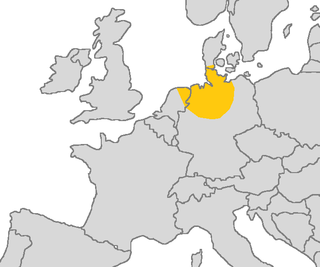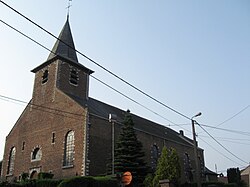Latin declension is the set of patterns according to which Latin words are declined—that is, have their endings altered to show grammatical case, number and gender. Nouns, pronouns, and adjectives are declined, and a given pattern is called a declension. There are five declensions, which are numbered and grouped by ending and grammatical gender. Each noun follows one of the five declensions, but some irregular nouns have exceptions.
The partitive case is a grammatical case which denotes "partialness", "without result", or "without specific identity". It is also used in contexts where a subgroup is selected from a larger group, or with numbers.
In grammar, the locative case is a grammatical case which indicates a location. It corresponds vaguely to the English prepositions "in", "on", "at", and "by". The locative case belongs to the general local cases, together with the lative and separative case.
Dual is a grammatical number that some languages use in addition to singular and plural. When a noun or pronoun appears in dual form, it is interpreted as referring to precisely two of the entities identified by the noun or pronoun acting as a single unit or in unison. Verbs can also have dual agreement forms in these languages.

Zoutleeuw is a municipality and city in the Hageland, in the extreme east of the Belgian province of Flemish Brabant. On 1 January 2018 the municipality had 8,498 inhabitants. The total area is 46.73 km2, giving a population density of 182 inhabitants per km2.
The grammar of the German language is quite similar to that of the other Germanic languages. Although some features of German grammar, such as the formation of some of the verb forms, resemble those of English, German grammar differs from that of English in that it has, among other things, cases and gender in nouns and a strict verb-second word order in main clauses.

Old Saxon, also known as Old Low German, was a Germanic language and the earliest recorded form of Low German. It is a West Germanic language, closely related to the Anglo-Frisian languages. It is documented from the 8th century until the 12th century, when it gradually evolved into Middle Low German. It was spoken throughout modern northwestern Germany, primarily in the coastal regions and in the eastern Netherlands by Saxons, a Germanic tribe that inhabited the region of Saxony. It partially shares Anglo-Frisian's Ingvaeonic nasal spirant law which sets it apart from Low Franconian and Irminonic languages, such as Dutch, Luxembourgish and German.
In linguistics, a compound is a lexeme that consists of more than one stem. Compounding, composition or nominal composition is the process of word formation that creates compound lexemes. Compounding occurs when two or more words or signs are joined to make a longer word or sign. A compound that uses a space rather than a hyphen or concatenation is called an open compound or a spaced compound; the alternative is a closed compound.
The grammar of Old English is quite different from that of Modern English, predominantly by being much more inflected. As an old Germanic language, Old English has a morphological system that is similar to that of the Proto-Germanic reconstruction, retaining many of the inflections thought to have been common in Proto-Indo-European and also including constructions characteristic of the Germanic daughter languages such as the umlaut.
The grammar of the Polish language is characterized by a high degree of inflection, and has relatively free word order, although the dominant arrangement is subject–verb–object (SVO). There commonly are no articles, and there is frequent dropping of subject pronouns. Distinctive features include the different treatment of masculine personal nouns in the plural, and the complex grammar of numerals and quantifiers.
In Modern English, I is the singular, first-person pronoun.

The English pronouns form a relatively small category of words in Modern English whose primary semantic function is that of a pro-form for a noun phrase. Traditional grammars consider them to be a distinct part of speech, while most modern grammars see them as a subcategory of noun, contrasting with common and proper nouns. Still others see them as a subcategory of determiner. In this article, they are treated as a subtype of the noun category.
Weak nouns are nouns that follow a weak inflection paradigm, in contrast with strong nouns. They are present in several Germanic languages.
Gothic is an inflected language, and as such its nouns, pronouns, and adjectives must be declined in order to serve a grammatical function. A set of declined forms of the same word pattern is called a declension. There are five grammatical cases in Gothic with a few traces of an old sixth instrumental case.

Uropi is a constructed language which was created by Joël Landais, a French English teacher. Uropi is a synthesis of European languages, explicitly based on the common Indo-European roots and aims at being used as an international auxiliary language for Europe and thus contributing to building a European identity.
Old Norse has three categories of verbs and two categories of nouns. Conjugation and declension are carried out by a mix of inflection and two nonconcatenative morphological processes: umlaut, a backness-based alteration to the root vowel; and ablaut, a replacement of the root vowel, in verbs.
Old High German is an inflected language, and as such its nouns, pronouns, and adjectives must be declined in order to serve a grammatical function. A set of declined forms of the same word pattern is called a declension. There are five grammatical cases in Old High German.
Historical linguistics has made tentative postulations about and multiple varyingly different reconstructions of Proto-Germanic grammar, as inherited from Proto-Indo-European grammar. All reconstructed forms are marked with an asterisk (*).
The grammar of Old Saxon is highly inflected, similar to that of Old English or Latin. As an ancient Germanic language, the morphological system of Old Saxon is similar to that of the hypothetical Proto-Germanic reconstruction, retaining many of the inflections thought to have been common in Proto-Indo-European and also including characteristically Germanic constructions such as the umlaut. Among living languages, Old Saxon morphology most closely resembles that of modern High German.
This article describes the grammar of the Old Irish language. The grammar of the language has been described with exhaustive detail by various authors, including Thurneysen, Binchy and Bergin, McCone, O'Connell, Stifter, among many others.





